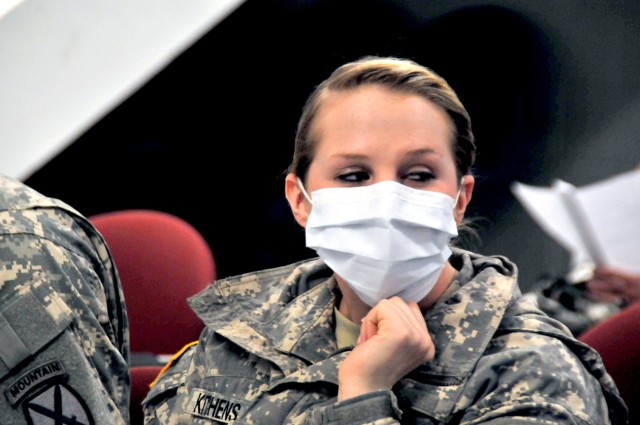FORT DRUM, NY -- What happens if 200 troops serving in Afghanistan are returning to the North Country after being exposed to a highly infectious disease' What if one Soldier has died, many more show serious symptoms and their plane now sits on a tarmac at Fort Drum'
Local, state and federal officials conducted a mass casualty exercise here April 13 preparing for such a scenario.
"We're exercising our ability to deal with the unlikely event that we would actually have an infectious agent coming back from Afghanistan," said Lt. Col. Douglas Badzik, MEDDAC chief of preventive medicine and acting public health emergency officer during the garrison exercise.
"If we don't plan for things, we're not going to be able to react the way we need to," he said.
A wall of emergency vehicles surrounded the Rapid Deployment Facility last week at Wheeler-Sack Army Airfield - ground zero of the simulated two-day event that involved Soldiers exposed to the Severe Acute Respiratory Syndrome, or SARS, virus.
Inside the facility, simulating 45 minutes since Soldiers began deplaning, medical and emergency officials wearing surgical masks combed the terminal, directing patients, gathering information and working two triage areas.
"When the patients come in, we take down their identifying information, their diagnosis and then we try to determine where they should go," said Staff Sgt. Marquisha Battle, MEDDAC, who handled admissions, dispositions and patient tracking at the primary triage.
She said that depending on an urgent, priority or delayed classification, patients were either quarantined to a secondary triage area or just watched and kept in isolation.
"We only quarantine them when they have symptoms," she said.
Badzik, the medical authority for the event, said roughly 10 percent of the 200 Soldiers were actually showing symptoms of the disease. He said unlike the pneumonic plague or other dangerous and extremely contagious agents, SARS is a relatively infectious virus spread through coughing or sneezing.
"Simply going and putting a mask on somebody is going to be enough to protect those droplets of the infection from passing from one person to another," he said.
History shows that any health issue at Fort Drum could unavoidably affect the greater North Country region, Badzik noted.
"Over the last couple of years, with the H1N1 virus outbreak and also the pertussis outbreak that we had this last year, what we recognized is that the diseases and the infections that happen here at Fort Drum certainly don't stay within the fence line," he said. "So the relationships we build and continue to strengthen with our community partners (are) really important."
Aaron Campbell, resident physician of internal medicine at Samaritan Medical Center in Watertown, was one of many community partners who participated on site last week. In addition to Samaritan and Carthage Area Hospital, personnel from Jefferson County Public Health, Jefferson County Coroner's Office and the New York State Department of Health also participated in the exercise.
"Since Fort Drum does not have a hospital, it becomes a good opportunity for the some of the community hospitals to participate in the care of the Soldiers," Campbell said.
Badzik pointed out that not only the medical aspect of the scenario was exercised. He said housing 200 Soldiers in an isolated area for an unknown period of time requires many additional provisions, including food services, sleeping areas, behavioral health professionals and chaplaincy support.
"We want to make sure we do everything we can to exercise our system (and) to help care for these Soldiers in every way that we possibly can," he said.
The exercise involved more than 100 participants on and off post. Badzik said planning occurred months ahead of time to get participants on the same page. A part of that planning, he explained, actually encouraged a good dose of failure.
"We don't know the things we don't know," he said. "Although certainly we hope to get this right during this incident, honestly, the small little things that don't go right is what we learn from a lot more.
"What we don't want to do is feed the right answers to our participants," he added. "If we were to do that ... we are just confirming what we already know."
Training for potential failures in knowledge or responses is a necessary facet of any contingency plan in a post-9/11 world, Campbell said.
"In the world that we live in now ... you just never know," he said. "Military targets are not the only targets that our enemies are out to (get). It's always hard to predict how you are going respond to a disaster situation."






Social Sharing